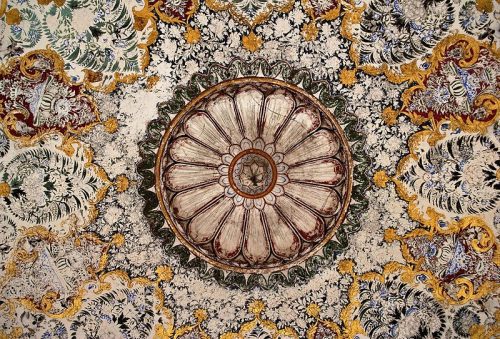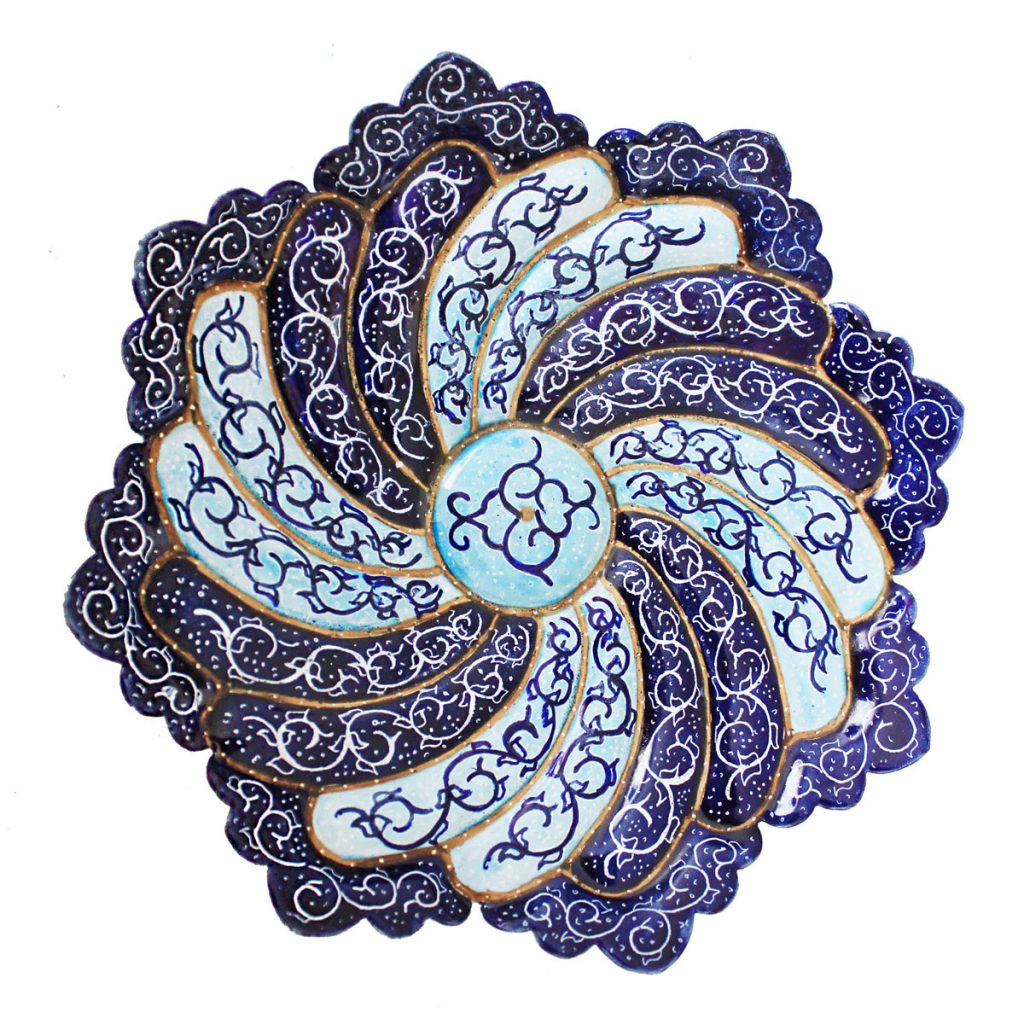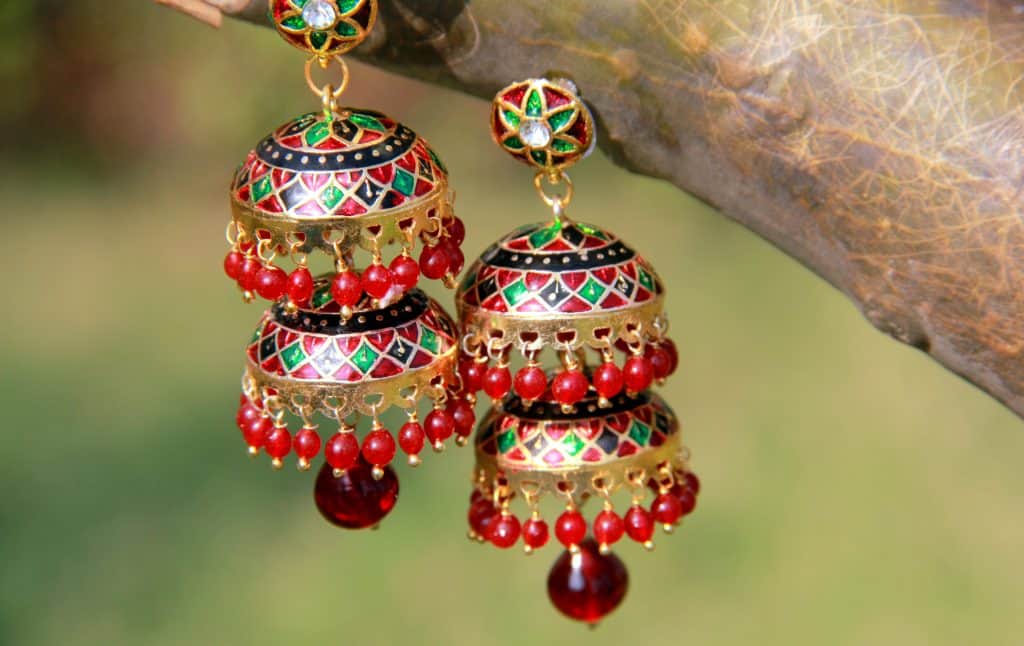Originating in Persia and adopted by the royal courts of Rajasthan, the Art of Meenakari is a centuries-old art form that adorns jewellery and decorative pieces with its dazzling enamelwork.

Minakari, also known as Meenakari, is an enamelling technique that was developed in Safavid-era Iran for the purpose of painting and colouring the surfaces of ceramic tiles and metal objects. The countries of Iran, Afghanistan, Pakistan, and India are the primary producers of this art form, which is also practised as an art form.
The fine patterns that are typical of minakari art are often used to decorate a wide range of things, such as jewellery, plates, containers, vases, frames, and other display items.
History of Meenakari
The history of the Meenakari craft may be traced back to Persia. Since “Mina” is the feminine form of the Persian word “Minoo,” which means “Heaven,” Mina is preoccupied with the cyan hue that represents heaven.
Craftsmen in Iran are credited with this technique’s invention, which was brought to people in other nations (including India) by the Mongolians. The Mughals, who were known for their love of elaborate Mughal jewellery, eventually became acquainted with this Shahi craft.
The Journey of Meenakari from Persia to India
Originating in Safavid Iran during the Sasanian era, Meenakari is a craft of enamelling that found its way to India through historical exchanges. It was introduced to Rajasthan at some point during the 16th century by Raja Man Singh (Amber), who requested the services of Meenakars from the court of the Mughals, which was situated in Lahore.
Due to him, these Meenakars were able to establish themselves in Jaipur, and as a result, the art was able to remain. These days, Jaipur is considered the Meenakari art capital of India. This marked the beginning of Meenakari’s evolution within the rich cultural tapestry of India, blending Persian influences with indigenous artistic traditions.
Legendary Meenakari Gems
Meenakari flourished as a royal splendour and cultural synthesis hallmark during the Mughal period. It adorned thrones, crowns, and architectural marvels commissioned by Mughal emperors, showcasing intricate designs and vibrant enamelling techniques.
These majestic artefacts, once symbols of imperial power and artistic finesse, now find their esteemed places in renowned museums such as the British Museum and the Metropolitan Museum of Art. Displayed to awe-inspiring effect, these pieces not only reflect the cultural richness of their era but also stand as a testament to the enduring allure of Meenakari artistry across centuries.
The Mughal queens, or begums, cherished Meenakari jewellery, incorporating these exquisite pieces into their collections as symbols of status and refinement. The art form extended beyond decorative purposes to encompass religious artefacts used in Hindu rituals, reflecting its adaptation and integration into diverse cultural practices across the Indian subcontinent.
The Mughals played a pivotal role in refining Meenakari, infusing it with a rich palette of colours and elaborate motifs that symbolized power, prestige, and cultural exchange.
Process of making meenakari
The production of meenakari is an extremely time-consuming, intricate, and challenging procedure. It calls for a significant amount of expertise as well as commitment. The process includes fusing coloured powder glass to a base made of a material such as metal, glass, or ceramics.
This is accomplished by subjecting the material to very high temperatures, often in the range of 750 to 850 degrees Celsius (1,380 to 1,560 degrees Fahrenheit) during the firing process. This results in the material being known as vitreous enamel or ceramic enamel, depending on which term you want.

On the metal, the glass, or the ceramics, the powder will melt and flow, and then it will cure into a vitreous coating that is smooth, long-lasting, and resilient. Any steel, stone, substance, or anything that can endure and maintain the fusing temperatures may have enamel applied to it. Enamel can be used in a variety of applications.
The chunk of steel that will be used for Meenakari is affixed to a lac stick before the process begins. On it are sculpted or engraved patterns of flora and fauna, such as flowers, birds, fish, and other animals, that are beautiful, intricate, and exquisite.
The enamel dust of the desired colour is then dispensed and hurried into the grooves after the walls and grooves necessary to retain and grab the colour have been generated as a result of this process.
The colour is melted by the temperature of the kiln, and the melted colour is distributed uniformly throughout the groove. The art of Meenakari is characterised by complex and ornate patterns that are created via the use of geometric lines and forms, along with other gorgeous motifs. Dishes for serving, vases, frames, displays, containers, and jewellery are all common places where you’ll find Meenakari art applied as a decorative element.
Metal oxides are combined with a little bit of powdered glass to create the colours that are used in enamelling. According to the scientific explanation, the shade of colour that is produced is determined by the oxide concentration of the material alone. These colours are ordered according to how difficult they get, starting with the one that is the most difficult of them all.
When the combinations are still in their unprocessed state, the colours do not appear immediately; rather, they appear only after the product has been heated in the furnace. Amritsar, Punjab, Germany, and France are the most common countries from which enamel colours are purchased and transported.

The Meenakari art style, which is featured on a wide range of objects, is well-known for having characteristics that are both distinctive and immediately noticeable. This includes things like anklets, earrings, jewellery boxes, picture frames, key chains, stools, seats for tiny temples, and even anklets and earrings.
The states of Rajasthan and Gujarat are the most well-known for the Meenakari products and jewellery that they produce, with Jaipur serving as the industry’s primary hub. In the enamelling done in Jaipur, traditional Mughal hues like red, green, and white are employed. It is common knowledge that Nathdwara, Bikaner, and Udaipur are famous for their silver. Glass enamelling is a speciality that may be seen at Meenakari and Pratapgarh.
Even in modern times, people in many parts of India continue to perform this art form. The hue known as gulaabi Meena, which is closer to rose pink, is the one most often seen in Banaras. Meenakari in Lucknow prefer to work with blue and green Meenakari rather than silver. Enamel work over gold is often done in Delhi, Banaras, and Jaipur.
Paintings created in the time-honoured and conventional style of Meenakari may be seen in collections all over the globe. It is grand, and it maintains its crown-worthy status by providing a sensation and experience befitting a monarchy. The artistic form is important to a large number of individuals in a variety of distinct ways. It can be found in all parts of the nation, and each region has developed its unique style and approach to implementing the art form.
Where to buy
Since the 16th century, Jaipur has served as the most important place for Meenakari jewellery. Other regions of the state are also known for making and selling Meenakari jewellery worldwide. Most Meenakari jewellery made of gold is made in Jaipur, Delhi, and Benaras.
Most Meenakari jewellery made of silver is made in the cities of Bikaner, Udaipur, and Nathdwara. The glass enamelling that is used in Meenakari jewellery that originates from the Pratapgarh area is in great demand due to the region’s more affordable price tags.
These hubs not only offer a wide range of traditional Meenakari items like jewellery, home decor, and religious artefacts but also provide insights into the intricate techniques and cultural significance behind each piece.
For those outside India, online platforms specializing in traditional crafts and artisanal goods often feature a selection of Meenakari art. Websites dedicated to promoting Indian handicrafts and international marketplaces showcase a diverse array of Meenakari paintings, sculptures, and jewellery, providing global accessibility to this cherished art form.
Additionally, art galleries and exhibitions worldwide occasionally feature Meenakari artworks, offering opportunities to acquire unique and curated pieces that blend historical craftsmanship with contemporary interpretations.
Celebrating the artistry and legacy of Meenakari
As admirers of Meenakari art, we are drawn not only to its rich historical roots and intricate craftsmanship but also to its enduring allure in contemporary times. Each piece, whether a delicately enamelled pendant or a vividly adorned vase, carries within it centuries of tradition and the skilled hands of artisans who have mastered this ancient craft. By owning a piece of Meenakari, we not only cherish its beauty but also become custodians of its cultural narrative, connecting us to a heritage that spans continents and epochs.
As we bring these treasures into our homes and lives, we celebrate the artistry and legacy of Meenakari, ensuring its timeless elegance continues to inspire and enchant for generations to come.
Read more: Latest



